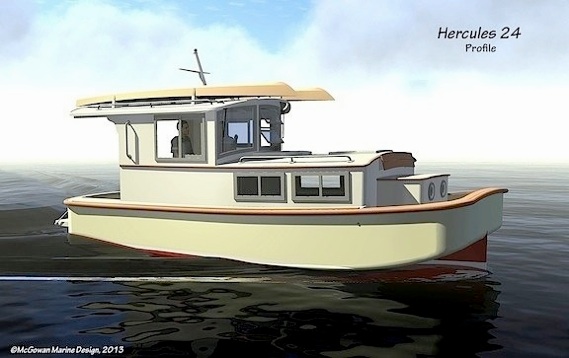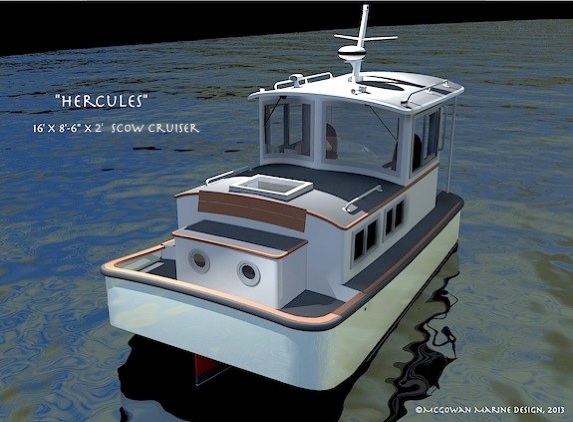
Copyright 2001-2021 inclusive McGowan Marine Design, Inc.
While trying to correct some longitudinal instability problems in a New Jersey pushboat (like a tugboat, but it pushes barges instead of pulling them) I looked at some quite different smaller scow pushboats and realized that with the addition of a lower hull, fantastic little cruisers could be based on such models.
Hercules is really a scow, but with a sleek central lower hull that houses a 20hp diesel (or electric motor), batteries, tanks, and foot-room below for two passengers. This is an example of a hull combo I really like: a dory and a canoe - with the dory (or flat bottomed boat) on top of a narrow canoe (equipment and foot space) hull. Usually the bottom of the dory is an interior deck of some sort, and a nice chine flat is formed on boats with pointed bows. In Hercules – a scow and a canoe really - a large part of this flat is used for good-sized berths. The scow part's chine is nicely radiused forward, and tapers to a small radius at the transom.
Hercules - an Able Micro-Cruiser
Starting from the drop-down swim platform (perfect for laying an 8’ tender on its side while steaming, or for access while at anchor) a coachroof-covered cockpit is aft of two comfortable helm seats. Roll-down tent and screen sides may be lowered from inside the coachroof edge to enclose this space for more comfortable bug-free cruising. The 20hp diesel, or 9kW electric motor is located below the cockpit in the centre hull, and is accessible from above and from the steps into the cabin.
Take those two steps down from the cockpit and you’re fully into the cabin, which features two large settee berths on each side and a folding table between. Boxes over the foot ends of the berths are also foot platforms for the crew at the helm seats. The berths are quite high off the cabin sole so fold-down footrests are located off the table legs. These fold up out of the way, under the table leaves, when not in use. A small though functional galley is forward of this, still with 6’-6” headroom (198cm) and the large forward hatch opens above this area. Forward of this is the head and storage area with 5’ of headroom (152cm), and with a chain locker in the bow and great wing storage in the bow quarters. As the pictures suggest, lighting and ventilation is excellent.
On deck above the head is the nicely-proportioned bow seat - perfect for one or two to hang out on while underway or at anchor. Access back to the cockpit is via the narrow side decks, with travel made easier by very good hand rails.
Particulars
LOA - 16’ (4.88m)
LWL - 16’ (4.88m)
Beam - 8’-6” (2.59m)
Draft - 2’ (0.61m)

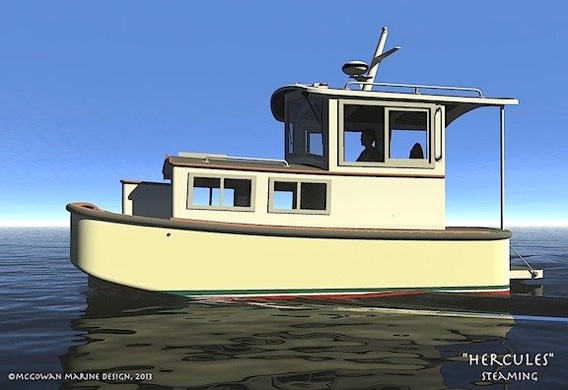
The vertical all-plywood cabin and topsides on Hercules have rounded corners, and there is a double-chined lower hull (hull bottom edge and the single chine, that is). It took some playing around to stop what is essentially a box from looking too much like one, and the resulting room is amazing.
Displacement - 4,000lbs. (1814 kg)
D/L - 436
Construction: plywood, epoxy/'glass
Engine - 20 hp diesel or 9kW electric
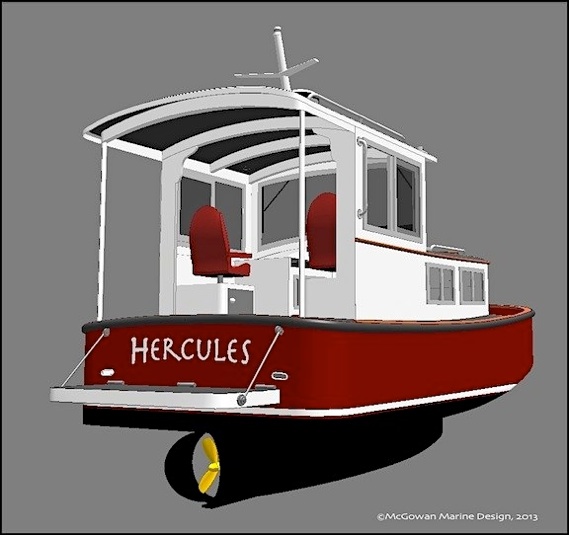
Great manoeuvrability and better steaming control and efficiency is provided with the laminated all-‘glass Kitchen Rudder around the propeller.
A friend suggested red would be an appropriate colour as the boat looks like a caboose. He could be right!
There has already been interest in a 24-footer (7.31m), Big Herc, which has more room in the cockpit (where two can sleep on mattresses) and has a sleeker shape - accomplished by taking the same-width hull and stretching it longer. No plans of either are completed but I’m working on the bigger one.
I still think that this would be a great little work tug or pushboat hull shape. And for bigger ones, say 25’ long and requiring twin engines, I’d add twin lowers hulls. “Why not just have a catamaran with the bridgedeck out of the water”, you ask? Because for pushboats and tugs the submerged wide and flat run is needed for ooomph when moving a big load… barges of stuff mostly.
Most small tugs shoulder their way through the water - like someone pushing through a crowd, but with a good bit of the displacement located in Hercules’ lower hull less of the upper hull may be submerged and its bottom (forward) be less steeply angled. With this hull shape the curve of areas is much more like the that of a finer cruiser than the chunky one of a scow or small tug, and performance estimates are encouraging: powering analysis shows that Hercules should steam at 6.5 knots using 18.1hp, and 6 knots at 13.4hp. Bear in mind this cruiser is meant for inshore waters (river, canal, and lake) as heading straight into a steep chop would be uncomfortable, and into a storm in the open - likely impossible. Still.... that’s a lot of fantastic cruising ground!
I became a fan of the power scow shape while a Sea Urchin diver for five winters in the Grand and Petit Passages between Long and Brier Islands, and Long Island and Digby Neck, here in Nova Scotia. Like a seal I would carefully watch the car ferries Spray and Joshua Slocum from the water, and marvel at their lack of quarter and stern waves. Some of that clean wave action might be due to the very long waterlines and relatively slow speeds, but when bucking the very strong tides at greater speeds the hull-produced waves are still very small. The water is usually flat aft, and the foam and bow waves seem to be absorbed by the forward motion of the ferries.
Some credit for this design has to go to two designers I admire: Nils Lucander for his keel work (the lower hull with its Swede-form shape is influenced by this) and especially by the very fun pedal cruisers of Phil Thiel. (He must have had a blast designing and using his boats.) Hercules makes a lot of people laugh and is very fun to work on as well.

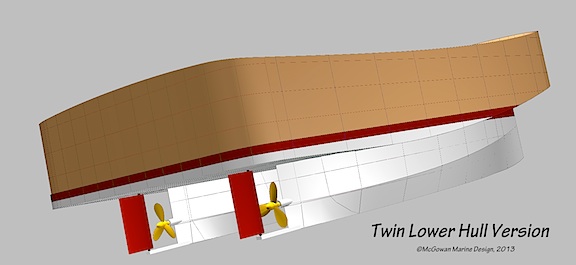

New - Fall 2013
A Big Herc: at 24’ x 8.5’ is in the works and with the same draft and beam as the 16-footer the hydrodynamics are much better. The layout keeps changing, with most emphasis on the wheelhouse area: great helm and co-pilot seats, good galley, with in-cockpit sleeping on an inflatable or fold-up bed in good weather. The former galley space forward is now storage, and there is a lot of room for the composting toilet or marine head. The lower hull has just a single chine - simplifying construction.
